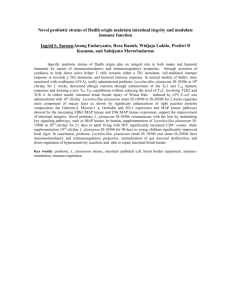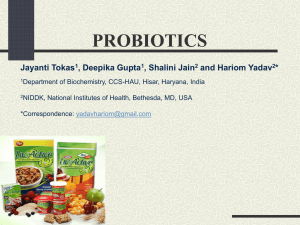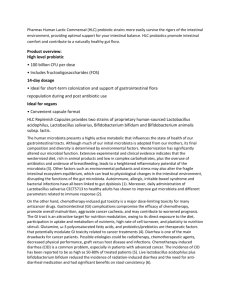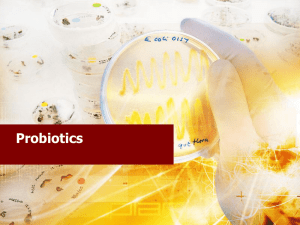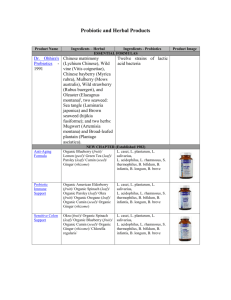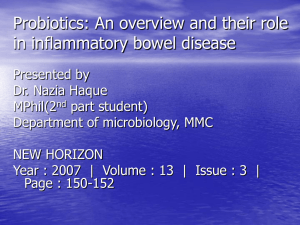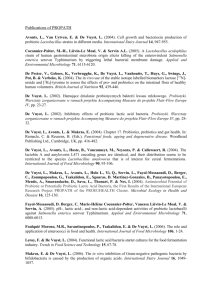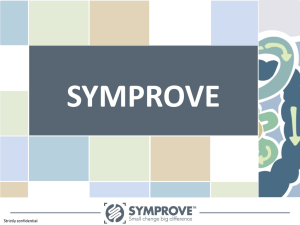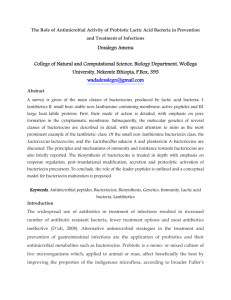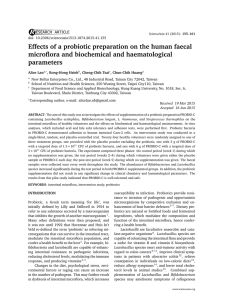Research - GORILLA fitness eshop
advertisement
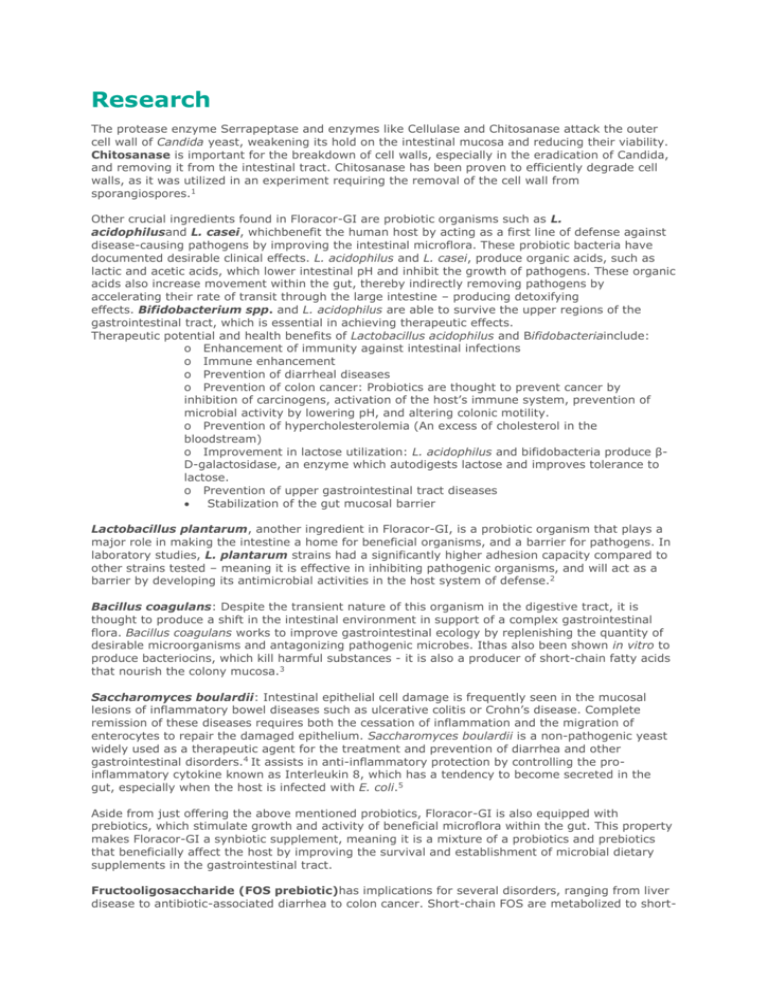
Research The protease enzyme Serrapeptase and enzymes like Cellulase and Chitosanase attack the outer cell wall of Candida yeast, weakening its hold on the intestinal mucosa and reducing their viability. Chitosanase is important for the breakdown of cell walls, especially in the eradication of Candida, and removing it from the intestinal tract. Chitosanase has been proven to efficiently degrade cell walls, as it was utilized in an experiment requiring the removal of the cell wall from sporangiospores.1 Other crucial ingredients found in Floracor-GI are probiotic organisms such as L. acidophilusand L. casei, whichbenefit the human host by acting as a first line of defense against disease-causing pathogens by improving the intestinal microflora. These probiotic bacteria have documented desirable clinical effects. L. acidophilus and L. casei, produce organic acids, such as lactic and acetic acids, which lower intestinal pH and inhibit the growth of pathogens. These organic acids also increase movement within the gut, thereby indirectly removing pathogens by accelerating their rate of transit through the large intestine – producing detoxifying effects. Bifidobacterium spp. and L. acidophilus are able to survive the upper regions of the gastrointestinal tract, which is essential in achieving therapeutic effects. Therapeutic potential and health benefits of Lactobacillus acidophilus and Bifidobacteriainclude: o Enhancement of immunity against intestinal infections o Immune enhancement o Prevention of diarrheal diseases o Prevention of colon cancer: Probiotics are thought to prevent cancer by inhibition of carcinogens, activation of the host’s immune system, prevention of microbial activity by lowering pH, and altering colonic motility. o Prevention of hypercholesterolemia (An excess of cholesterol in the bloodstream) o Improvement in lactose utilization: L. acidophilus and bifidobacteria produce βD-galactosidase, an enzyme which autodigests lactose and improves tolerance to lactose. o Prevention of upper gastrointestinal tract diseases Stabilization of the gut mucosal barrier Lactobacillus plantarum, another ingredient in Floracor-GI, is a probiotic organism that plays a major role in making the intestine a home for beneficial organisms, and a barrier for pathogens. In laboratory studies, L. plantarum strains had a significantly higher adhesion capacity compared to other strains tested – meaning it is effective in inhibiting pathogenic organisms, and will act as a barrier by developing its antimicrobial activities in the host system of defense.2 Bacillus coagulans: Despite the transient nature of this organism in the digestive tract, it is thought to produce a shift in the intestinal environment in support of a complex gastrointestinal flora. Bacillus coagulans works to improve gastrointestinal ecology by replenishing the quantity of desirable microorganisms and antagonizing pathogenic microbes. Ithas also been shown in vitro to produce bacteriocins, which kill harmful substances - it is also a producer of short-chain fatty acids that nourish the colony mucosa.3 Saccharomyces boulardii: Intestinal epithelial cell damage is frequently seen in the mucosal lesions of inflammatory bowel diseases such as ulcerative colitis or Crohn’s disease. Complete remission of these diseases requires both the cessation of inflammation and the migration of enterocytes to repair the damaged epithelium. Saccharomyces boulardii is a non-pathogenic yeast widely used as a therapeutic agent for the treatment and prevention of diarrhea and other gastrointestinal disorders.4 It assists in anti-inflammatory protection by controlling the proinflammatory cytokine known as Interleukin 8, which has a tendency to become secreted in the gut, especially when the host is infected with E. coli.5 Aside from just offering the above mentioned probiotics, Floracor-GI is also equipped with prebiotics, which stimulate growth and activity of beneficial microflora within the gut. This property makes Floracor-GI a synbiotic supplement, meaning it is a mixture of a probiotics and prebiotics that beneficially affect the host by improving the survival and establishment of microbial dietary supplements in the gastrointestinal tract. Fructooligosaccharide (FOS prebiotic)has implications for several disorders, ranging from liver disease to antibiotic-associated diarrhea to colon cancer. Short-chain FOS are metabolized to short- chain fatty acids, lowering pH in the colon. This facilitates calcium absorption, which may be beneficial for individuals with renal and liver disease, and has implications for colon cancer protection as well. Short-chain fatty acids are the preferred substrate for colonic epithelial cells, which are potentially beneficial for those with ulcerative colitis risk.Other effects of short-chain FOS include an effect on cholesterol metabolism through interference with enterohepatic circulation of cholesterol. Short-chain FOS allow for a favorable shift in the balance of healthful vs harmful organisms, lowering colonic pH while providing an energy source for the gut, with significant implications for disease prevention.6 Enzymes & Herbs How It Works Alfalfa Powder Promotes colon health and is a rich source of vitamins and minerals, and protein. It works well with prebiotics in promoting overall digestive health. Amla Also known as Indian gooseberry (Emblica officinalis); a natural and efficacious antioxidant, and one of the richest sources of absorbable Vitamin C. Papaya Juice Powder From green papaya; it is dehydrated at a controlled temperature to ensure its maximum nutritional value. Retains the natural proteolytic enzyme papain, which has been used for centuries as an effective digestive aid. Lactobacillus acidophilus Probiotic that produces lactic acid, which inhibits the growth of pathogenic bacteria and yeasts. Lactobacillus casei Probiotic that produces lactic acid and has a wide pH and temperature range; complements the growth of L. acidophilus in the production of the enzyme amylase. Lactobacillus bulgaricus Probiotic widely known to increase longevity; cooperates with L. acidophilus in creating a protective colonization in the intestinal tract. Lactobacillus plantarum Probiotic that works with L. acidophilus in inhibiting pathogens; also produces L-lysine, a beneficial amino acid. Lactobacillus brevis Species of lactic acid bacteria; prevalent in fermented foods such as sauerkraut and pickles; found to improve the immune system health. Lactobacillus caucasium Species of lactic acid bacteria used for its health-promoting properties Lactobacillus helveticus Lactic acid producing rod shaped bacterium of the genus Lactobacillus; most commonly used in the production of cheese. Some research indicates powdered milk fermented with L. helveticus helps reduce blood pressure. Bifidobacterium bifidum A probiotic well-documented for its adverse effect on pathogenic or disease causing bacteria; bifidobacteria aid in digestion, and are often used as probiotics (good bacteria) for their immune stimulating properties. SEBiotic® (Bacillus coagulans) Spore-forming lactogenic probiotic with the trade name SEBiotic. As with other probiotics, it demonstrates significant immune strengthening properties. As a spore forming probiotic and through our Enhanced Probiotic Delivery System (EPDS), more SEBiotic is delivered to the gut where the bacteria begin to germinate, and eventually colonize. Makes minerals bioactive and available to the cells of the body including probiotics. They stimulate metabolism, enhance respiration, increase metabolism of proteins, the activity of multiple enzymes, enhances the permeability of cell membranes and promotes cell division. Saccharomyces boulardii Probiotic that helps maintain and restore the balance of microflora in the large and small intestine. Fructooligosaccharides (FOS) Short-chain sugars that stimulate the growth of probiotics in the digestive system. Sources: 1. Faber T, Foos K. (2006). Use of Chitinase and Chitosanase to Form Sphaeroplasts From Pilobolus Sporangiospores. Proceedings of the Indiana Academy of Science. 115(1):1-6. 2. Kumar A, M. N. (January 2012). Isolation of Lactobacillus Plantarum From Cow Milk and Screening For the Presence of Sugar Alcohol Producing Gene. Journal of Microbiology and Antimicrobials, Vol. 4(1), pp. 16-22. 3. J, J. (March 2002). Bacillus Coagulans. Alternative Medicine Review, 76-81. 4. Czerucka D, D. S. (Oct 2000). Saccharomyces Boulardii Preserves the Barrier Function and Modulates the Signal Transduction Pathway Induced in Enteropathogenic Escherichia Coli-Infected T84 Cells. Infect Immun. , 68(10):59986004. 5. Voichishina LG, C. V. (1991). The Use of Sporulating Bacteria in Treating Patients with Dysbacteriosis.Vrach Delo, 12: 73-75. 6. D, N. (Oct 2000). Intestinal Warfare: The Role of Short-Chain Fructooligosaccharides in Health and Disease. Nutr. Clin Care, Vol 3:5 pp 266-273.

